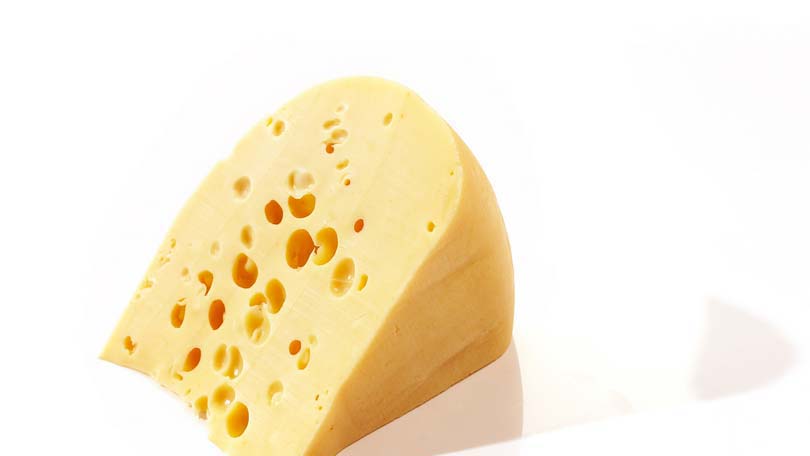Hailing from Switzerland and traditionally named for its region of origin, the term “Swiss cheese” is no longer limited to that part of the world. Many varieties of the pale yellow, nutty-flavored cheese are now produced all around the world.
Swiss cheeses from Switzerland, like the famous Emmental and Gruyere, are typically crafted of unpasteurized, raw milk. Swiss cheeses produced in the United States, like Aged, Baby, and Lacy or Lorraine Swiss, are made from pasteurized cow’s milk.
Aged Swiss is a strong, sharply flavored cheese. Its texture is firm compared to the other varieties. Both Baby and Lacy Swiss are semi-soft with a relatively milder flavor. Baby is made with whole milk, and Lacy is made with low-fat milk.
Swiss cheese hues range from a creamy ivory to a deeper yellow. Its flavor, often described as nutty, varies from very mild to quite sharp.
When storing Swiss cheese, keep in mind that its flavor intensifies as it ages. Swiss cheese will last tightly wrapped in the refrigerator up to two months as blocks, or up to one month if sliced.
To freeze Swiss cheese for later use, store ½-pound (or smaller) blocks in zip-lock baggies. It will last in the freezer up to six months, but should be used within several days after thawing in the refrigerator. After being frozen, Swiss cheese may be crumbly upon thawing, but will make a fine ingredient in cooked recipes. Swiss cheese grates best cold, but tastes best at room temperature.
One question people often have about Swiss cheese is how it gets its holes. Actually, these holes are technically called “eyes,” and they are formed by microbiological activity. There are three strains of bacteria used in the production of Swiss cheese; one of the bacteria strains gobbles up the lactic acid that the others produce, emitting carbon dioxide in the process. This emission makes bubbles, which in turn forms the eyes. The speed of the bubbling process – and the size of the eyes – can be impacted by acidity, curing time, and temperature.
Industry standards have recently changed to accommodate processing concerns. It used to be that Swiss cheese eyes needed to be between 11/16 and 13/16 of an inch (that’s about the size of a nickel) to be stamped Grade A. Much to the frustration of producers, the large holes often got caught in the slicing machinery. United States commercial cheese makers requested that regulators rethink the size requirements. Now cheese with holes as small as 3/8 of an inch, about half the originally required size, can earn the highest grade.
Known for melting easily with a good result, Swiss makes a fine addition to cheese-based recipes. Too high of heat will result in a rubbery product, though, so it is best to use a consistent medium heat when melting Swiss.
With its name derived from “fondre,” French for “to melt,” fondue was invented as a way to use up hardened cheese and dry bread. Equally at home après ski or following cocktail hour, fondue now enjoys a particularly fun reputation far removed from its peasant roots. Tasty and relatively easy to make, it brings to mind good friends sitting around the fondue pot, laughing and sharing a delicious meal.
Swiss Fondue
1 pound Swiss cheese, grated
2 tablespoons all-purpose flour
1 clove garlic
2 cups dry white wine
2 tablespoons Kirsch or brandy (optional)
1/4 cup Parmesan cheese, grated
1/4 teaspoon ground nutmeg
For dipping:
French and Pumpernickel bread, cubed into bite-sized pieces
Apple slices
Assorted vegetables – cauliflower, broccoli, celery
Toss Swiss cheese with flour to coat cheese evenly; set aside.
Cut the garlic clove in half, then rub all over the interior of the fondue pot to evenly disperse the juices.
Pour white wine into fondue pot and gently bring to a simmer; do not boil.
Add the Swiss cheese to the hot wine a handful at a time, stirring constantly with a wooden spoon.
After all of the cheese has been added and melted, add the Kirsch or brandy, Parmesan cheese, and nutmeg.
Heat until just boiling, stirring constantly.
Serve with bread, fruit, and vegetables for dipping.
Traditionally, the penalty for losing a piece of bread or other dipper in the fondue was that the offender was required to buy dinner for everyone else.






